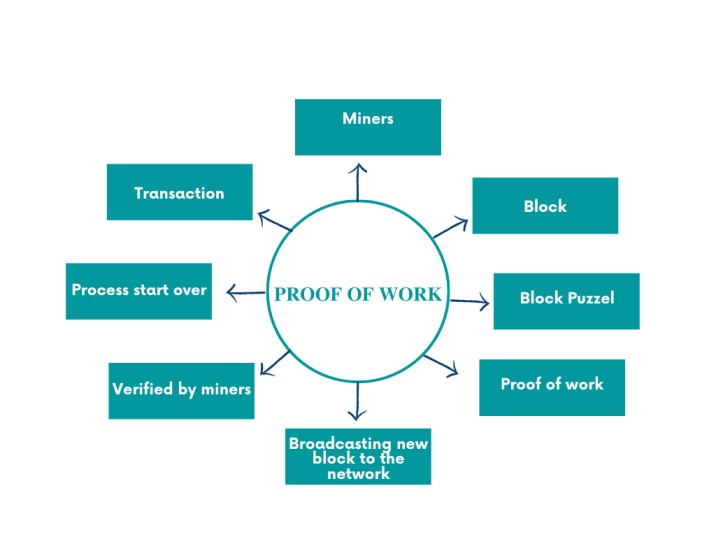Before starting you should be familiar with the electricity grid and proof of work .
What Is Proof of Work ?
Proof of work is a Decentralised consensus process that prevents system-gaming by requiring network participants to invest time and effort in resolving an arbitrary mathematical puzzle. In cryptocurrency mining, proof of work is usually applied for transaction validation and token mining. Proof of work enables safe peer-to-peer processing of Bitcoin and other cryptocurrency transactions without the need for a reliable third party. Huge amounts of energy are necessary for proof of work at scale, and this requirement only grows as more miners join the network.
How does it work?

With this approach, a number of people compete with one another to solve a challenging mathematical puzzle. The block would then be broadcast to the network for verifications by any user who successfully found the solution. The block then moves to confirm the state when the users have verified the solution.
There are several different groups of decentralised nodes in the blockchain network. These nodes serve as the blockchain’s administrators or miners, which are in charge of adding new blocks to the ledger. Instantaneously and at random, the miner chooses a number that is then mixed with the block’s data. In order to add the freshly created block to the main chain, the miners must choose a valid random number by coming up with the right answer. It rewards the miner node for figuring out the answer by paying a reward.
The block was then subjected to a hash function, which produced output that satisfied all input/output requirements. Other nodes in the network validate and verify the conclusion after it is discovered. The hash of the previous block is stored in each new block. A chain of blocks results from this. They operate together to store data on the network. To change a block, you need to create a new block that contains its predecessor. To regenerate all successors and update their data would be extremely difficult. This prevents tampering with the blockchain.
It takes a lot of processing power and time to do the computations necessary for an effective assault on a blockchain network. Hacks are ineffective because of Proof of Work since it would cost more to attack the network than it would be worth. Additionally, miners are encouraged not to lie. It remains one of the most widely used strategies for achieving consensus in blockchains.
Proof-of-Work Coin list:
- Bitcoin 2. Dogecoin 3. Ethereum Classic 4. Litecoin 5. Monero 6. Bitcoin Cash 7. Zcash 8. Ravencoin 9. Dash 10. Decred
What is Electric Grid?

Power plant generates electricity from three types of energy resources:
- Fossil fuels, such as natural gas and coal
- Nuclear power
- Renewable energy sources, including solar, wind, and hydro power

High-Voltage Transmission Lines
High-voltage transmission lines carry high-voltage electricity over long distances.Up to 500,000 volts are carried by these high-voltage power lines. Power is transmitted at a high voltage to improve efficiency by reducing energy loss.High-voltage lines carry power from the power plants to substations, often over long distances.
How Substations Work
Substations Transformers reduce the voltage when electricity from high-voltage transmission lines enters a substation so that it can be distributed to homes and businesses.Fuses at substations are used to divide the current into several distribution lines.The distribution lines allow the supply of electricity to left the substation when it is ready to be distributed to homes and businesses.
What is power grid failure?
A certain frequency is used to transmit electricity.When the frequency reaches its minimum or maximum level, there is a risk of failure of transmission lines.Thus, the breakdown of transmission lines due to over or under frequency is called Power Grid Failure.
How crypto solve the power grid failure problem.
The worldwide energy consumption for the Cryptocurrency could increase dramatically over the next five years, adding many gigawatts of demand.There is a rising movement within the cryptocurrency sector to rethink cryptomining equipment as possible grid assets that may help balance demand and promote renewable energy as concerns about utilities’ carbon footprints grow.
Crypto makes it possible for mining utilities to enter into partnerships that benefit both the electrical grid and the miners.Crypto mining is being used today to provide not only flexible income for utility providers and energy generators, but also providing stability Electric Grid.To do this, mining companies enter into arrangements with these energy suppliers to halt operations during periods of high demand.
Energy companies and miners have a more complex relationship than just that. By enabling energy grids to run at full capacity and giving them a chance to be profitable during off-peak demand periods, mining operations also end up giving them a certain level of robustness and durability.This fresh source of income may enable companies to build up capital invest money in expanding services, upgrading services and equipment. The fact that mining contributes to the strengthening of electrical infrastructure is crucial; how this newly discovered income is allocated or spent is ultimately irrelevant.

Naren is a finance graduate who is passionate about cryptocurrency and blockchain technology. He demonstrates his expertise in these subjects by writing for cryptoetf.in. Thanks to his finance background, he is able to write effectively about cryptocurrency.
